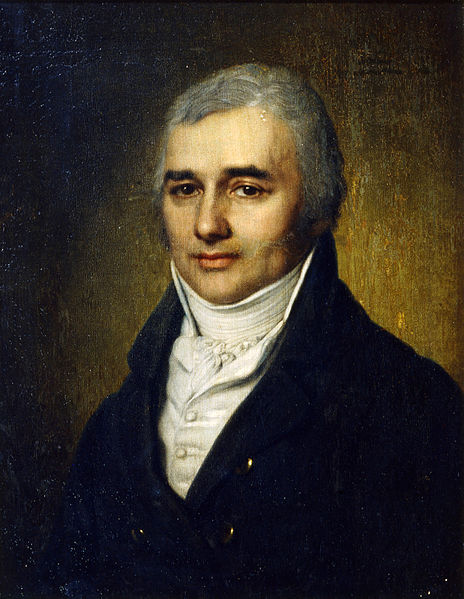Beethoven’s younger brother Carl had been working as his secretary and business manager when, on 25 May 1806, Carl married Johanna Reiss, the daughter of an upholsterer. She was already several months pregnant.
This marriage was to cause much unhappiness among all concerned.
As Beethoven began working on sketches for a new set of three string quartets, he uncharacteristically wrote down an exact date to mark the event: 26 May 1806. It is not known if this exact dating had anything to do with his brother’s marriage the previous day.
Beethoven hadn’t written any string quartets since 1800’s Opus 18 (Day 125f). Six years later, Beethoven’s style had evolved considerably, and the new quartets reflect his increased confidence, daring, and individuality. They “breathe in a different world” as Joseph Kerman notes.
The new string quartets were commissioned by Count Andreas Kyrillovitch Razumovsky (b. 1752), a wealthy Russian who had married into the family of Prince Lichnowsky in Vienna and served as the Czar’s ambassador to the Viennese court.

“Razumovsky lived in Vienna like a prince,” it was recalled years later, “encouraging art and science, surrounded by a luxurious library and other collections and admired and envied by all; what advantages accrued from all this to Russian affairs is another question.”
Count Razumovsky was also characterized by a contemporary as an “enemy of the Revolution but a friend to the fair sex.” One of the women who he was said to have had an affair with was the Queen of Naples.
Razumovsky was also a skilled violinist, good enough to play second violin in string quartets. In 1808 he founded and maintained his own string quartet led by Ignaz Schuppanzigh (Day 142) as first violinist. Beethoven’s quartets were among their specialties.
In 1805, Count Razumovsky commissioned three string quartets from Beethoven with the stipulation that each contains a Russian folk tune. Beethoven complied, but the Russian tunes are perhaps the least interesting aspect of what have come to be known as the Razumovsky Quartets.
Unlike the six Opus 18 string quartets, the Razumovsky Quartets have clearly emerged from the shadows of Mozart and Haydn. With four movements each and the first some 40 minutes in length, they have a symphonic scope and individual quirky personalities.
Maynard Solomon writes,
Where Beethoven’s creative laboratory had at first been the piano and then the symphony orchestra, the focus of his experimental efforts was now transferred to the string quartet…. [T]hese quartets are interior monologues addressed to a private self whose emotional states comprise a variegated tapestry of probing moods and sensations…. Here, in these quartets, he will reveal his most inner feelings and strivings. (Beethoven p. 260–1)
Beethoven established a role for the string quartet as a medium for the composer’s most intimate musical statements. This special status of the string quartet became particularly prominent in the 20th century with composers such as Janáček, Bartók, Schoenberg, Shostakovich, Weinberg, Carter, Feldman, Haas, and others.
At this time, Beethoven’s fundamental attitude toward life was based on his realization of the victory that may be achieved by heroism in spite of suffering…. The hero marches forth, indubitably heroic, but performing his feats before the whole of the applauding world. What is he like in his loneliness? We find the answer in the Rasoumovsky quartets. — J. W. N. Sullivan, Beethoven: His Spiritual Development
Joseph Kerman writes:
coming upon the first “Razamovsky” Quartet after the six of Op. 18 is like coming into a new artistic universe. It is like a first reading of Chapman’s Homer, a first visit to Athens or Venice, a first kiss. The richness of detail, the originality and fertility of musical idea, the commanding coherence, the sheer smooth density and complexity of it all, are fairly breathtaking…. There had never been such a quartet before.... (Beethoven Quartets, p. 100)
Beethoven had gotten into the habit of beginning compositions unconventionally as if to announce that he was no longer bound by the old rules. The first movement of the String Quartet No. 7 begins with the lyrical main theme surprisingly played by the cello. Yet soon after Beethoven has shifted that theme to the more common first violin, he begins pushing that instrument into higher and higher registers, creating a density of sound that spans five octaves.
The 2nd movement of the String Quartet No. 7 again begins with the cello but this time it’s a four-measure one-note rhythmic motif that commences what William Kinderman calls “a search for its own thematic material.” (Beethoven p. 133) The movement is labeled “Allegretto vivace e sempre scherzando” (“lively and always joking”), but it’s not structurally a Scherzo unless you allow two Trio sections. It’s witty, whimsical, feisty, but above all eccentric.
The 3rd movement of the String Quartet No. 7 is labeled “Adagio molte e mesto,” that word “mesto” (“mournful”) not being used since Beethoven’s Piano Sonata No. 7 (Day 101). We first expect a single tragic theme, but Beethoven has supplied several, and early Beethoven scholar A. B. Marx reputedly discovered ten shifting moods in the 15-minute movement.
In the sketches for this movement Beethoven mysteriously wrote “A Weeping Willow or Acacia Tree over my Brother’s Grave.” Nobody ventures to guess what that means.
The penultimate movement of the String Quartet No. 7 leads right into the finale — another of Beethoven’s gestures becoming more common — and this he labeled “Thème russe,” although the main theme (once again introduced by the cello!) might not sound very Russian to our ears.
#Beethoven250 Day 195
String Quartet No. 7 “Razumovsky” in F Major (Opus 59, No. 1), 1806
A splendid performance by the Danish String Quartet (@DanishQuartet) at a church in New Jersey.
On 5 July 1806, Beethoven wrote to his publisher about his
new violin quartets, one of which I have already finished; and indeed I am thinking of devoting myself almost entirely to this type of composition.
Such devotion would not be possible for another two decades.